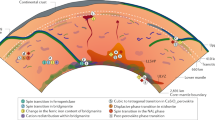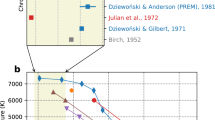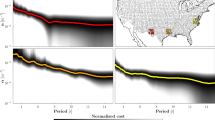Abstract
IT is well known that elastic wave velocities are independent of frequency only for a non-dissipative medium1. In a real solid dispersion must accompany absorption. This effect has been emphasised by Randall2 and Liu et al.3. The effect is small when the seismic quality factor Q is large or unimportant if only a small range of frequencies is being considered—that is, the spectra of P waves. Even in these cases, however, the measured velocities, or inferred elastic constants, are not the true elastic properties but lie between the high frequency and low frequency limits or the so-called ‘unrelaxed’ and ‘relaxed’ moduli. The magnitude of the effect depends on the nature of the absorption band and the value of Q. When comparing data taken over a wide frequency band the effect of absorption can be considerable especially considering the accuracy of present body-wave and free-oscillation data. Thus, Jeffreys4 questions conclusions based on free oscillation data, particularly where they differ from body-wave results which are based on much shorter periods. Carpenter and Davies5 and Davies6 attempted to reconcile body-wave and surface-wave Earth models by allowing for physical dispersion using Futterman's7 and Kolsky's8 dispersion–absorption relationships. Jeffreys4 used Lomnitz'9 relationships. Liu et al. have shown that dispersion depends to first-order on absorption in the seismic frequency band and derived a linear superposition model that gives a Q that is independent of frequency. It can be shown that all of the above theories give equivalent absorption–dispersion relations for moderate absorption. Liu et al.3 and Anderson et al.10 have shown how to correct surface-wave and free-oscillation data for physical dispersion. Much of the support for the existence of an upper mantle low velocity zone has come from the inversion of normal mode data that have been uncorrected for physical dispersion due to absorption. In the light of these developments, we decided to re-examine the question of a shearwave low velocity zone.
This is a preview of subscription content, access via your institution
Access options
Subscribe to this journal
Receive 51 print issues and online access
$199.00 per year
only $3.90 per issue
Buy this article
- Purchase on Springer Link
- Instant access to full article PDF
Prices may be subject to local taxes which are calculated during checkout
Similar content being viewed by others
References
Zener, C., Elasticity and Anelasticity of Metals (University of Chicago Press, Chicago, 1948).
Randall, M., Physics of Earth and Planetary Interiors (in the press).
Liu, H., Anderson, D. L., and Kanamori, H., Geophys. J. R. astr. Soc. (in the press).
Jeffreys, H., Nature, 215, 1365–1366 (1967).
Carpenter, E., and Davies, D., Nature, 212, 134 (1966).
Davies, D., Geophys. J. R. astr. Soc., 13, 421–424 (1967).
Futterman, W., J. geophys. Res., 67, 5279 (1962).
Kolsky, H., Phil. Mag., 8, 693 (1957).
Lomnitz, C., J. appl. Phys., 28, 201 (1957).
Anderson, D. L., Kanamori, H., Hart, R., and Liu, H., Science (in the press).
Jeffreys, H. and Bullen, K., Seismological Tables (Br. Ass. Adv. Sci., London, 1940).
Bullen, K., The Earth's Density (Wiley, New York, 1975).
Anderson, D. L., and Hart, R., J. geophys. Res., 81, 1461–1475 (1976).
Anderson, D. L., Ben-Menahem, A., and Archambeau, C. B., J. geophys. Res., 70, 1441 (1965).
Jordan, T., and Anderson, D. L., Geophys. J. R. astr. Soc., 36, 411 (1974).
Author information
Authors and Affiliations
Rights and permissions
About this article
Cite this article
ANDERSON, D., HART, R. Absorption and the low velocity zone. Nature 263, 397–398 (1976). https://doi.org/10.1038/263397b0
Received:
Accepted:
Issue Date:
DOI: https://doi.org/10.1038/263397b0
Comments
By submitting a comment you agree to abide by our Terms and Community Guidelines. If you find something abusive or that does not comply with our terms or guidelines please flag it as inappropriate.



